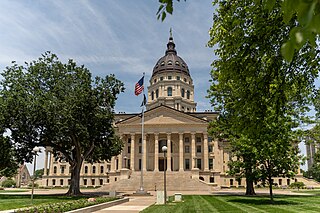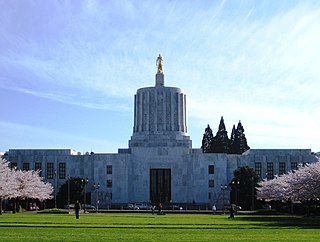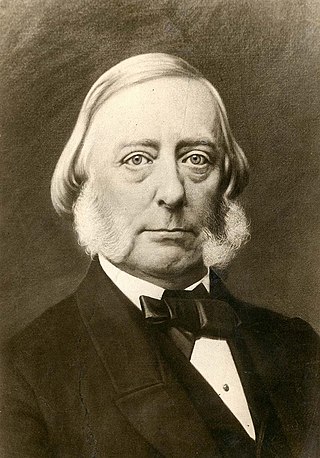
Shawnee County is located in northeast Kansas, in the central United States. Its county seat and most populous city is Topeka, the state capital. As of the 2020 census, the population was 178,909, making it the third-most populous county in Kansas. The county was one of the original 33 counties created by the first territorial legislature in 1855, and it was named for the Shawnee tribe.

Bleeding Kansas, Bloody Kansas, or the Border War, was a series of violent civil confrontations in Kansas Territory, and to a lesser extent in western Missouri, between 1854 and 1859. It emerged from a political and ideological debate over the legality of slavery in the proposed state of Kansas.

The Territory of Kansas was an organized incorporated territory of the United States that existed from May 30, 1854, until January 29, 1861, when the eastern portion of the territory was admitted to the Union as the free state of Kansas.

The Wyoming State Capitol is located in the city of Cheyenne. Cheyenne is the seat of government for the U.S. state of Wyoming, also hosting the workspace for the governor, and his staff; Mark Gordon. Built between 1886 and 1890, the capitol is located in Cheyenne and contains the chambers of the Wyoming State Legislature as well as the office of the Governor of Wyoming. It was designated a U.S. National Historic Landmark in 1987. The Capitol underwent an extensive three-year renovation and reopened to the public on July 10, 2019.

The New Mexico State Capitol is the seat of government of the U.S. state of New Mexico, located in its capital city of Santa Fe. It houses both chambers of the New Mexico Legislature and the offices of the Governor, Lieutenant Governor, and Secretary of State. The building is one of only eleven state capitols without a dome, and the only circular state capitol in the United States, for which it is commonly known as "the Roundhouse".

The Utah Territorial Statehouse, officially Territorial Statehouse State Park Museum, is a state park in Fillmore, Utah. The museum and park preserves the original seat of government for Utah Territory before the capital was moved to Salt Lake City in 1856. Built from 1852 to 1855, the statehouse was initially intended as a larger structure, but only the south wing was completed before the project was abandoned due to lack of federal funding. After its construction, the Utah Territorial Legislative Assembly met in the building for only one full session and parts of two others.

The Kansas State Capitol, known also as the Kansas Statehouse, is the building housing the executive and legislative branches of government for the U.S. state of Kansas. Located in the city of Topeka, which has served as the capital of Kansas since the territory became a state in 1861, the building is the second to serve as the Kansas Capitol. During the territorial period (1854–1861), an earlier capitol building was begun but not completed in Lecompton, Kansas, and smaller structures in Lecompton and Topeka were where the territorial legislatures met.

The Oregon State Capitol is the building housing the state legislature and the offices of the governor, secretary of state, and treasurer of the U.S. state of Oregon. It is located in the state capital, Salem. Constructed from 1936 to 1938 and expanded in 1977, the current building is the third to house the Oregon state government in Salem. The first two capitols in Salem were destroyed by fire, one in 1855 and the other in 1935.

Shawnee Methodist Mission, also known as the Shawnee Mission, which later became the Shawnee Indian Manual Labor School, is located in Fairway, Kansas, United States. Designated as a National Historic Landmark in 1968, the Shawnee Methodist Mission is operated by the city as a museum. The site is owned by the Kansas Historical Society and administered as the Shawnee Indian Mission State Historic Site.

The Kansas Legislature is the state legislature of the U.S. state of Kansas. It is a bicameral assembly, composed of the lower Kansas House of Representatives, with 125 state representatives, and the upper Kansas Senate, with 40 state senators. Representatives are elected for two-year terms, senators for four-year terms.

First Capitol Historic Site is a free-admission historic museum located outside Belmont, Wisconsin, United States. The museum includes two of the buildings first used by legislators to meet in Wisconsin Territory. Currently owned and operated by the Wisconsin Historical Society, the site is listed on the National Register of Historic Places.

Pawnee is a ghost town in Geary County, Kansas, United States, which briefly served as the first official capital of the Kansas Territory in 1855. Pawnee was the territorial capital for exactly five days – the legislature met there from July 2 to July 6 – before legislators voted to move the capital to Shawnee Mission, which is located in present-day Fairway. It may be the shortest-lived capital of any U.S. state or territory.

The Kansas House of Representatives is the lower house of the legislature of the U.S. state of Kansas. Composed of 125 state representatives from districts with roughly equal populations of at least 19,000, its members are responsible for crafting and voting on legislation, helping to create a state budget, and legislative oversight over state agencies. Representatives are elected to two-year terms. The Kansas House of Representatives does not have term limits. The legislative session convenes at the Kansas State Capitol in Topeka annually.

Andrew Horatio Reeder was the first governor of the Territory of Kansas.
The Nebraska Territorial Legislature was held from January 16, 1855, until February 18, 1867, in Omaha City, Nebraska Territory.
The timeline of Kansas details past events that happened in what is present day Kansas. Located on the eastern edge of the Great Plains, the U.S. state of Kansas was the home of sedentary agrarian and hunter-gatherer Native American societies, many of whom hunted American bison. The region first appears in western history in the 16th century at the time of the Spanish conquest of the Aztec Empire, when Spanish conquistadors explored the unknown land now known as Kansas. It was later explored by French fur trappers who traded with the Native Americans. It became part of the United States in the Louisiana Purchase of 1803. In the 19th century, the first American explorers designated the area as the "Great American Desert."

Lecompton Constitution Hall, also known as Constitution Hall, is a building in Lecompton, Kansas, that played an important role in the long-running Bleeding Kansas crisis over slavery in Kansas. It is operated by the Kansas Historical Society as Constitution Hall State Historic Site.
The First Nebraska Territorial Legislature first met in Omaha, Nebraska, on January 15, 1855. The Council Bluffs and Nebraska Ferry Company provided the first meeting place, which was a building "constructed for public purposes". Standing out from the estimated twenty shacks in the young town, it was the first brick building in Omaha, which was founded the year before when the Nebraska Territory was created. Responsible for several important decisions that laid an important foundation for the future statehood for Nebraska, the Nebraska Territorial Legislature made controversial decisions and provided leadership for the territory.

The Kansas Historical Society is the official state historical society of Kansas.
Events from the year 1855 in the United States.



















